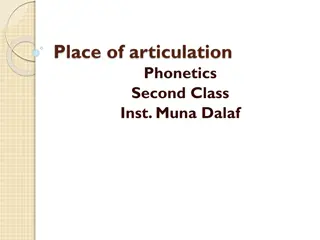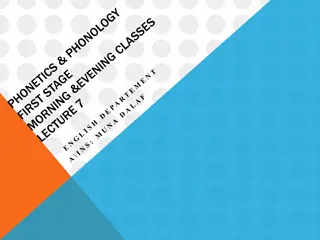Prevention and Combating of Hate Crimes and Hate Speech Bill [B.9B.2018]
The Prevention and Combating of Hate Crimes and Hate Speech Bill aims to address incidents motivated by prejudices through the creation of offenses of hate crimes and hate speech. It seeks to prevent and combat these offenses by defining hate crimes, hate speech, and establishing measures for prosec
7 views • 18 slides
Articulatory Aspects of English Speech Sounds
Speech sounds are integral to language, with articulatory, acoustic, auditory, and functional aspects. Articulation involves mechanisms like the power, vibrator, resonator, and obstruction mechanisms. The power mechanism includes the respiratory system, while the vibrator mechanism operates through
10 views • 10 slides
AB 1111 and AB 928
Explore the significant impacts of Assembly Bills AB 1111 and AB 928 on daily work related to student transfer goals. Learn about the role of the Articulation Officer in supporting faculty and articulation efforts. Discover key concepts such as intersegmental transfer, general education, and baccala
2 views • 24 slides
Stereotypes, Hate Speech, and Freedom of Speech
This lesson explores the topics of hate speech, stereotypes, and the boundary between freedom of speech and hate speech. It delves into the origins of hate speech, the connection between stereotyping and hate speech, and how stereotyping can lead to violence. The discussion also touches on the impor
4 views • 14 slides
ARTICULATION
Delve into the world of Computer-Supported Collaborative Work (CSCW) and the role of anthropology in understanding technology and social practice. Uncover key concepts like awareness, articulation work, and appropriation in group collaboration. Discover how technologies are shaped by their environme
0 views • 20 slides
Direct and Reported Speech in English
Explore the differences between direct and reported speech, learn how to convert direct speech into reported speech, and understand when to use each form in writing. Direct speech uses the speaker's actual words in quotes, while reported speech conveys the gist of what was said without using exact w
3 views • 20 slides
Speech Acts and Politeness in Linguistics
This informative content explores the concepts of speech acts, including direct and indirect speech acts, and the role of politeness in communication. It highlights how speakers convey intentions through their utterances, distinguishing between different speech acts such as requesting, commanding, a
2 views • 11 slides
Mastering the Art of Using Speech Marks for Direct Speech
Learn how to effectively use speech marks (inverted commas/quotations marks) to punctuate direct speech. Discover the rules for using speech marks, examples of correctly punctuated sentences, and when to use question marks in speech. Enhance your writing skills with proper speech punctuation.
5 views • 27 slides
English Consonant Sounds: A Detailed Guide
This guide delves into the English phonetics and linguistics classification of consonant sounds, emphasizing factors such as place of articulation and manner of articulation. It covers various types of consonant sounds, from bilabial and labio-dental to alveolar, post-alveolar, palatal, velar, and g
1 views • 11 slides
Intelligibility in Dysarthria: Survey of SLPs
Dysarthria is a speech disorder impacting speech processes, with neurological disruptions seen in conditions like ALS, traumatic brain injury, and Parkinson's disease. Intelligibility, the listener's understanding of speech, is crucial for quantifying dysarthria's impact. Factors like speech tasks,
1 views • 15 slides
Examples of Reported Speech Transformation
This content provides examples of how direct speech sentences are transformed into reported speech sentences. Various scenarios are depicted, such as a doctor advising a patient, a policeman warning a thief, requests from individuals to others, and commands given by authority figures. Each direct sp
2 views • 23 slides
Direct and Indirect Speech in English
Direct speech involves reporting exact words spoken, while indirect speech conveys the same message using different words. Learn about the rules for changing pronouns and key aspects of both direct and indirect speech. Master the art of transforming sentences from direct to indirect speech with ease
3 views • 15 slides
Assistive Speech System for Individuals with Speech Impediments Using Neural Networks
Individuals with speech impediments face challenges with speech-to-text software, and this paper introduces a system leveraging Artificial Neural Networks to assist. The technology showcases state-of-the-art performance in various applications, including speech recognition. The system utilizes featu
1 views • 19 slides
Freedom of Speech in Nomination Speech: Analysis and Insights
Exploring the boundaries of freedom of speech in a nomination speech for a student government candidate, highlighting elements that may not align with protected freedoms under the First Amendment. The speech emphasizes firm beliefs and dedication but raises questions about appropriateness and potent
0 views • 30 slides
Speech Therapy Guidelines and Medicare Regulations Overview
This content provides detailed information on writing person-centered functional goals in speech therapy, emphasizing SMART goals and best practices. It covers course descriptions, objectives, and Medicare regulations related to speech therapy services. The importance of reasonable and necessary evi
0 views • 90 slides
SAQA's Role in Implementing the Articulation Policy in Higher Education
SAQA presented progress made in implementing the Articulation Policy to the Parliamentary Portfolio Committee on Higher Education & Training. The policy aims to create linkages within the South African post-school education system. SAQA's responsibilities include setting criteria for articulation, c
1 views • 33 slides
Articulation in Phonetics and Speech Production
Exploring the vocal tract, active and passive articulators, and the complexity of the tongue's role in speech production. Identifying primary places of articulation and the intricate coordination of speech organs in producing sounds. Discover the significance of the rest position and how different p
3 views • 22 slides
Direct and Reported Speech Punctuation
Distinguishing between direct and reported speech is essential. Direct speech quotes the exact words using inverted commas, while reported speech summarizes without the same words, often in the past tense. In direct speech, present tense and inverted commas are used but not in reported speech.
1 views • 31 slides
Speech and Language Developmental Milestones: A Bilingual/Multilingual Perspective
Speech and language developmental milestones are crucial for children, regardless of their home language. These milestones encompass receptive language, expressive language, pragmatics, and articulation and phonology. Understanding how a child hears and talks from birth to one year is essential, as
2 views • 23 slides
Clarinet Articulation: Techniques and Strategies
Delve into the nuances of clarinet articulation with the University of North Texas faculty as they discuss the importance of slurring, tonguing, and airflow. Learn about effective breathing techniques, tongue positioning, and the role of air in creating a strong sound. Discover valuable resources fo
0 views • 23 slides
Ensuring Free Speech Rights at Michigan State University
Michigan State University's Trustees emphasize the importance of protecting free speech on campus. The university's philosophy supports campus dissent, promoting a healthy exchange of ideas. Recent incidents, like protesters disrupting a speaker's event, raise concerns about safeguarding free speech
0 views • 11 slides
Statewide Articulation Agreement between MCCB and IHL
This statewide articulation agreement between the Mississippi Community College Board (MCCB) and the Institutions of Higher Learning (IHL) ensures smooth transfer of credits between community colleges and public universities in Mississippi. It outlines the courses accepted for transfer, is reviewed
0 views • 18 slides
Overview of Second Class Instinctive Place of Articulation in Phonetics
Place of articulation in phonetics refers to the location where speech sounds are obstructed. There are 8 types of place of articulation, including bilabial, labio-dental, dentals, alveolar, palato-alveolar, palatal, velar, and glottis. Each type is characterized by the specific articulatory positio
0 views • 10 slides
The Organs of Speech: An Insightful Presentation
Delve into the fascinating world of organs of speech with this comprehensive presentation by Assistant Professor Shri Bahegavankar L.G. Learn about the respiratory system, phonatory system, and articulatory system, exploring the functions of the lungs, muscles of the chest, windpipe, larynx, and voc
0 views • 29 slides
Fictional Speech and Phonostylistics in Literature
Delve into the realm of fictional speech and phonostylistics within literature, examining the representation of speech versus real speech, the encoding of spatial, social, and attitudinal markers, and the significance of fictional speech in creating immersive narratives. Discover how authors navigat
0 views • 30 slides
Cases of Hate Speech in Public and Student Speech Scenarios
The content discusses instances of hate speech in two different scenarios. In the public employee speech case, a building inspector's tweets lead to his firing and subsequent legal action. In the student speech case, a high school junior's involvement in a white nationalist demonstration causes disr
0 views • 16 slides
Articulation and Transferability in Curriculum Development
Explore the world of articulation and transferability in curriculum development in this informative content. Learn about the differences between CCC articulation, CSU GE, IGETC, C-ID/ADT, and more. Discover the types of articulation and external approving bodies, along with best practices for approv
0 views • 8 slides
Sounds of Second Class Phonetic Manner of Articulation
Fricative sounds, produced by narrowing the air passage, create hissing sounds like /f/, /v/, /s/, /z/, and more. Affricates start as stops and end as fricatives, like in "chin" and "chest." Explore examples of sounds and articulation processes in English phonetics.
0 views • 6 slides
Music: Elements and Characteristics Explained
Explore the diverse elements that make up music, from melody and articulation to dynamics, time/tempo, structure, harmony, and instruments. Learn about the nuances of each aspect, including melody registers, articulation techniques, dynamic variations, tempo changes, structural formats, harmonic pri
0 views • 10 slides
Hate Speech and Fake News in the Balkans
This study delves into the prevalence of hate speech and fake news in the Balkans, shedding light on the harmful impact of such communication. It discusses the lack of an international legal definition for hate speech and explores how fake news spreads through fabricated stories, often disseminated
1 views • 27 slides
Treatment Approaches for Childhood Apraxia of Speech (CAS)
Childhood Apraxia of Speech (CAS) is a neurological speech disorder impacting speech precision and consistency. Despite the lack of a gold standard treatment due to limited well-controlled studies, various principles guide therapy approaches. Key features of CAS include inconsistent errors in speech
0 views • 36 slides
The Role of a Speech-Language Pathologist in Schools
As a Speech-Language Pathologist (SLP) in a school setting, your job involves assessing and treating children with communication disorders that impact their academic success and social interaction. Requirements in Kansas include a Master's degree, supervised clinical practicum, passing exams, and co
0 views • 24 slides
Overview of Fricative Sounds in English Pronunciation
This content discusses various fricative sounds in English pronunciation, focusing on the articulation of sounds like /s/ and /z/. It covers the positioning of the soft palate, tongue, teeth, and lips while producing these sounds, providing examples like "thin," "think," "free," and more. The conten
1 views • 11 slides
Indirect Speech: Examples and Practice
Indirect speech involves reporting what someone else has said without quoting them directly. In this content, you will find examples and exercises on how to convert direct speech into indirect speech, covering statements, commands, and requests. Practice transforming sentences like "My parents are v
2 views • 8 slides
English 9th Grade - Reported Speech in Everyday Situations
In this English lesson for 9th graders, students learn about reported speech through a scenario where a student, Ana, asks her classmates for help with a research project. The classmates respond with reasons they cannot help, and Ana later recounts their responses using reported speech. The lesson a
0 views • 19 slides
Transfer Articulation Maintenance Challenges
Transfer articulation maintenance poses challenges such as unarticulated work, clerical errors, and lack of organization. The process involves understanding business processes and Banner data structure, despite limited IT support. To overcome these challenges, a systematic mapping project is impleme
0 views • 25 slides
TRANSFER ARTICULATION MAINTENANCE
The Transfer Articulation Maintenance Bug-MI Conference held on September 25, 2015, featured Jon Davidson, Director of Admissions, and Lee Cruppenink, Assistant Director of Admissions from the University of Michigan-Flint.
0 views • 14 slides
Evolution of Articulation Officer Role
The role and responsibilities of articulation officers in higher education institutions have evolved significantly. This evolution includes serving as information managers, liaisons between campuses and external entities, and key players in curriculum development and compliance. Articulation officer
0 views • 16 slides
REPORTED SPEECH 1
Reported speech is a method of narration used to convey what others have said at a specific time, commonly known as "he said/she said." It is vital in communication, especially in interviews and conversations. Learn about the two kinds of reported speech, its usage in the past, and examples to enhan
0 views • 8 slides
Meet Mrs. Mallory Foster - Speech-Language Pathologist
Mrs. Mallory Foster is a dedicated speech-language pathologist based in Enterprise, AL. With a strong educational background and a passion for helping children, she creates a fun and nurturing environment for speech therapy sessions. Mrs. Foster uses evidence-based practices, games, and various acti
0 views • 5 slides
![Prevention and Combating of Hate Crimes and Hate Speech Bill [B.9B.2018]](/thumb/60513/prevention-and-combating-of-hate-crimes-and-hate-speech-bill-b-9b-2018.jpg)






































